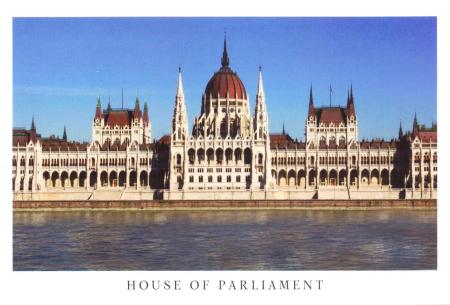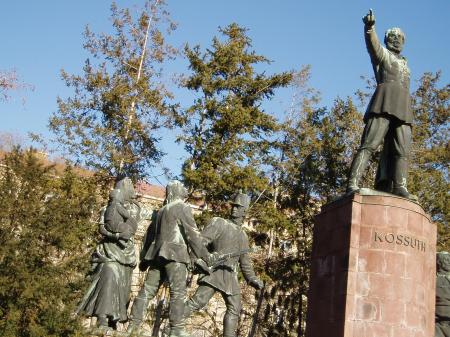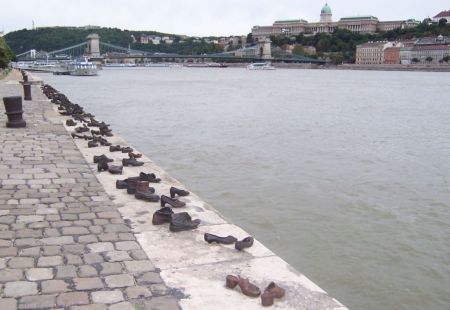There was some marginal improvement in the weather after lunch as the swirling mists over the Danube began to retreat and a watery sun tried to force its way through the fog but by mid afternoon it seemed certain that it was destined to fail.
We were in full speed sightseeing mode now and next it was St Stephen’s Basilica which at ninety-six metres high is the tallest building in Budapest. Actually the Hungarian Parliament building is also ninety-six metres high which might sound a bit of a coincidence but in fact is quite deliberate because the number ninety-six refers to the nation’s millennium, 1896, and the conquest of the later Kingdom of Hungary in 896.
The Basilica is named in honour of Stephen, who was the first King of Hungary from 1000 to 1038 and whose mummified fist is kept in a shrine at the back of the church. I’m afraid that I have no explanation about what happened to the rest of him.

Seven years after Budapest was united from the three cities in 1873 the National Assembly resolved to establish a new representative Parliament Building that appropriately expressed the sovereignty of the nation.
A competition was announced, which was won by the architect Imre Steindl and construction was started in 1885 and the building inaugurated on the one thousandth anniversary of the country in 1896 (no surprises there) and finally completed in 1904. During construction the project was a major employer in the city and there were about one thousand people working on its building in which forty million bricks, half a million precious stones and forty kilograms of gold were used. It is the third largest Parliament building in the World after those in Romania and Argentina.
Although it has an eastern appearance it is similar to the Palace of Westminster in London and was built in the same Gothic Revival style with a symmetrical façade and a central dome. It is two hundred and sixty-eight metres long and one hundred and twenty-three metres wide. Its interior includes ten courtyards and six hundred and ninety-one rooms.
It is set in the spacious Louis Kossuth Square and there is plenty of room to wander around and admire the magnificence of the building. Louis Kossuth was the man who led the 1848 revolution that attempted to overthrow the Hapsburgs and there is a large monument to his memory at one end of the square.
At the other end is a statue of Imre Nagy, another Hungarian martyr and hero who was Prime Minister during the post war occupation years and led the ill-fated 1956 anti-soviet government rebellion after the revolution of the same year attempted to break free from Soviet control.
Nagy’s government formally declared its intention to withdraw from the Warsaw Pact and pledged to re-establish free elections. By the end of October this had seemed to be entirely successful but on 4th November a large Soviet force invaded Budapest and during a few days of resistance an estimated two thousand five hundred Hungarians died and a further two hundred thousand more fled as refugees. Mass arrests and imprisonments continued and a new Soviet installed government was installed, an action that strengthened Soviet control over Central Europe for several more years. Nagy was executed for treason in 1958.
Even with half price entrance fees (2,000 Florints) for citizens of the European Union there wasn’t a great deal of enthusiasm to visit the interior of the building and after a show of hands it was only Sue and I that paid up and waited in line to go inside while the others made their various ways back to the Hotel Gellért.
The forty minute tour took us up wide open staircases, through elaborately decorated corridors, magnificently appointed state rooms and into the debating chambers but the highlight was the central dome (ninety-six metres high, remember) and in pride of place the fabulous crown of Saint Stephen.
The Holy Crown is the most important part of the Hungarian Crown Jewels because it represents the authority to rule in the country. Budapest took a bit of a pounding in the Second-World-War and as the Russian Red Army arrived it was removed from the country in 1945 for safekeeping and entrusted to the United States Government. It was kept in a vault at Fort Knox until 1978, when it was returned to the nation by order of US President Jimmy Carter and it is now kept at the Hungarian Parliament building where it belongs.
It is a pity that Jimmy Carter doesn’t run the British Museum because then the Elgin marbles might get returned to Athens.
The tour over, Sue and I walked back to the hotel along the east bank of the Danube and passed close by a famous piece of Budapest street art. The Shoes on the Danube Bank is a memorial that remembers the Jews who were killed by fascist Arrow Cross militiamen in Budapest during World War II. They were tied together in pairs, lined up and ordered to take off their shoes and were shot at the edge of the water so that their bodies fell into the river and were carried away by the current.
The Arrow Cross was a national socialist party which led a government in Hungary known as the Government of National Unity from October 1944 to March 1945. During its short rule it is estimated that up to fifteen thousand people were murdered on the streets and eighty-thousand people were deported to their deaths in the Auschwitz concentration camp. It is said that they were so nasty that even Adolf Hitler thought they were extreme!
While everyone got ready for evening meal Mike and I found a curious drinking den just around the corner, it was scruffy and uncomfortable but with a half a litre of Hungarian beer costing less than a pound we were happy to stop there for two.
As soon as everyone had assembled in the lobby we returned to the river because the price of the city bus tour included a one hour evening river cruise so we made our way to the quayside and took the ride as far as Margaret Island one way and then to the Hotel Gellért going the other. The cruise provided a different perspective of the city as we sailed under the illuminated castle on the Buda side and the Parliament building in Pest.
After returning to the quay we went into the city and I was nervous about dining because I had insisted on finding somewhere traditionally Hungarian but was worried that anywhere could match the excellence of the Greek restaurant the previous night. We found somewhere and I was right it didn’t really compare but we enjoyed acceptable ethnic Hungarian food and then after a long day wandered slowly back to the hotel.






While in Austria, we were served a meal with three different potato dishes. I am certain that your meal was better.
LikeLiked by 1 person
Potato three ways is a culinary masterpiece!
LikeLike
There is so much wretched history in that part of the world. (Well, most parts of the world, really, I suppose.)
LikeLike
Sadly, that is true and it still goes on. We learn little!
LikeLike
A mummified fist? Like you I am most curious about the rest of the body parts. Yikes.
I believe Jimmy Carter just celebrated his 90th birthday. Perhaps he could be called in to see what he can do about those notorious Elgin marbles. 🙂
LikeLike
He did well. I can remember pictures of him collapsing that time in a road race. I thought he was dead then!
LikeLiked by 1 person
Apparently a false alarm. 🙂
LikeLiked by 1 person
So man atrocities in this world! That last picture, after the story, hits hards.
Gorgeous buildings, though.
LikeLike
It’s a tough story isn’t it?
I should really have told the story of Carl Lutz who was the Swiss Vice Consul in Budapest who together with the Swedish diplomat Raoul Wallenberg are generally acknowledged with saving over 60,000 Jews through the issue of Swiss/Swedish documents and ‘protective letters’ which enabled them to leave Budapest and travel to Palestine. We all know about Oskar Schindler but Carl Lutz was responsible for the largest rescue operation of Jews of the Second World War.
LikeLike
I’ve heard the name Carl Lutz before, but cannot recall where or how. Thank you for this additional information.
LikeLike
I meant: so m.a.n.y. atrocities. Ooops. My apologies.
LikeLike
I guessed that.
LikeLiked by 1 person
What did you think to the local beer? I wasn’t a big fan at all, but it beats Unicum!
LikeLike
At 70p for half a litre it was ok. There were lots of scruffy bars with cheap beer – I liked that!
LikeLike
Oh yes Unicum barf
LikeLike
Must confess that I didn’t try it!
LikeLike
Pingback: Entrance Tickets, The Budapest Parliament Building | Have Bag, Will Travel
I like the post but not some of the details, each for obvious reasons.
I’ve heard first-hand tales of war from my mother. Germans occupied the area of Yugoslavia where she lived (now Croatia). Hard to imagine living through such times, much as it’s hard to imagine conditions in all current areas of armed conflicts and ethnic violence.
And, yes, humans never learn, even when they can plainly see the lessons of history. Always, reasons are found to hate and kill.
LikeLike
We cannot turn a blind eye to history. The Balkans are a particularly difficult region of Europe. Germany annexed Yugoslavia in 1943 and as a consequence created the puppet state of Croatia. Invading German troops were withdrawn quite quickly to join the Eastern Front and in charge was a Croat Government led by an fascist organisation called Ustase. It is said that these Croats made good Nazis and they were responsible for ethnic cleansing and the murder of tens of thousands of Serbs, the complete annihilation of the Romany population in the region and were enthusiastic supporters of the Jewish final solution. Another thoroughly unpleasant bunch!
LikeLike
There are still hard feelings in the area. One of the reasons I’m never going back there. People have long memories when it comes to that period of time. I was actually born in what is now Slovenia but lived in what is now Croatia, but the people where I lived were mostly of Italian descent (Triestini).
I wrote a brief history of what little I know of my background here:
There’s a whole half of my ancestry that I know nothing about (my father died when I was one year old). Never bothered to look them up.
LikeLike
Thanks for the link, I enjoyed the family history. I have visited this part of Croatia and stayed in Pula.
Istria has a strong Italian heritage and before 1945 had a majority Italian population. The new Yugoslav Government carried out a policy of ‘soft’ ethnic cleansing which made life so difficult for Italians that they were all obliged to leave!
Nice binoculars as well!
LikeLike
They didn’t make it easy to leave. My family escaped (I was one at the time). I left behind homes and land I inherited from my biological father (I know next to nothing of that side of the family). Those were sold sometime in the 60s by people forging my name. Apparently, one of the homes is now a hotel. Last I heard (back in the 90s) I still owned a piece of land that wasn’t suited for anything, not that I’m ever going back there to check.
LikeLike
Land theft was common in post war Europe. If you still own land then chances are it is quite worthless.
LikeLike
That was in the 90s and I’m sure it’s gone by now, but yes, it was worthless even back then.
LikeLiked by 1 person
The Shoes on the Danube Bank is powerful piece of art. It’s beautiful, thought provoking and horrifying at the same time. I find it even more disturbing than King Stephen’s mummified fist, and that’s saying something.
LikeLiked by 1 person
More horrific because it is so more recent!
LikeLike
Familiar from our visit to Budapest last year – except we didn’t go into the Parliament building. The shoes are very moving.
LikeLike
Enjoyed the tour, Andrew. And good for Jimmy Carter. The Arrow Cross sounds like a very scary group. And I always remind myself such things can happen again and wonder if we aren’t getting closer. –Curt
LikeLike
I think they probably still do Curt.
The more I read the more the Second World War gets complicated. Nazi’s weren’t exclusively German and some of the cruellest soldiers came from German Ally States!
LikeLike
I saw a news story yesterday that reported that the government of Poland recently claimed that the Jews were partially responsible for World War II.
LikeLike
And absolved all Poles of any responsibility for the persecutions or the Holocaust. It is causing a lot of trouble.
LikeLike
As it should, Andrew.
LikeLike
Very interesting post – we saw the Parliament and it was magnificent at night but didn’t have time to go round on our trip. The history was very moving – the Hungarian people have suffered so much over the centuries.
LikeLike
The Parliament Tour is really good, a pity you missed it! What plans do you have for 2018?
LikeLike
I would pay to go on that tour,
The 20th century is/was a sad time in world history, I wonder how it/we will be viewed 500 years hence
LikeLike
I imagine that it will go through several reinterpretations along the way!
LikeLiked by 1 person
It would be nice to know how they will view us
LikeLiked by 1 person
I enjoy your posts…We’ve got a riverboat cruise coming up, ending in Budapest, so I found this especially relevant. Politics in Hungary seem to be revisiting the past with the rise of fascism again – we never learn😢. What a moving memorial on the river bank – so poignant.
LikeLike
Pingback: Travels in Spain, Montserrat and the Black Madonna | Have Bag, Will Travel
Pingback: A to Z of Statues – K is for Louis Kossuth in Budapest | Have Bag, Will Travel
Eastern Europe has a dreadful murderous history that repeats itself over and over. And for what?
LikeLike
The only certain thing about history is that it repeats itself.
LikeLiked by 1 person
I found the shoes along the riverbank so incredibly moving. I still tear up when I see the pictures.
LikeLike
It is indeed a shocking story.
LikeLike